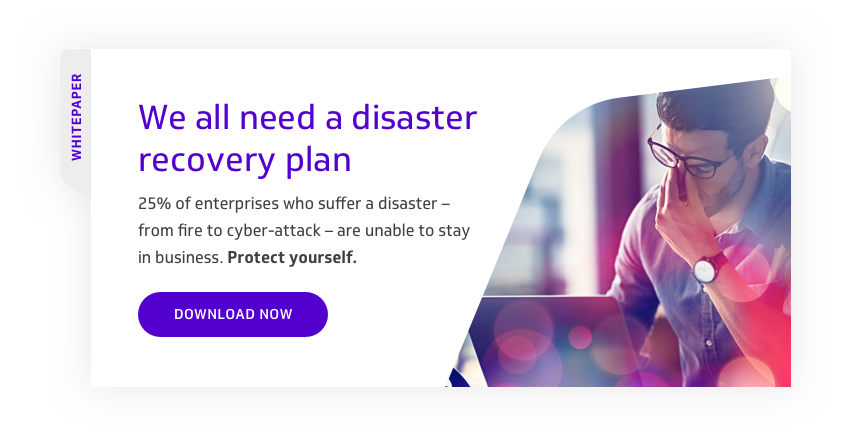BLOG
The True Cost of Disaster Recovery – Can you Afford to be Complacent?
Putting a specific price on the cost of DR (disaster recovery) plans following a disaster is an impossible task. In the same way as no two people are the same, neither are any two businesses. So much depends on the unique nuances of your business, including how many people work for you, the nature of your industry, or even the amount of time your business could afford to stall before it grinds to a halt.
One thing is universally true: every business needs a form of disaster recovery plan in a world where data is king.
As a business, you might think that talk of a ‘disaster’ sounds a little too dramatic. This couldn’t be further from the truth, as an unforeseen data disaster could lead to:
- Downtime – resulting from the inability to use your IT infrastructure, or the data you need to do your work.
- Loss of productivity and disruption to your workforce
- Losing your key clients.
- Lost productivity while you spend time communicating with you stakeholders.
- Spending excessive time to recover your data which will be costly
- Emergency IT services (always at a higher cost)
- Potential fines for non-GDPR compliance depending on how the disaster occurred and what measures you had in place to prevent it happening
- Legal expenses – potentially resulting from a loss of important information.
- Firefighting
Can you put a price on your time?
With our millennial workforces used to being able to rely on IT systems, any time that they can’t work following a disaster will have a huge impact. After all, time is a commodity that we never have enough of.
Your business won’t be able to continue functioning for long once the worst happens. For you, the time costs come in finding the IT firefighter who can help you get back up and running (at a premium) and a loss of productivity amongst your employees whilst systems remain down and data is recovered.
Then there’s the time considerations when thinking about your customers and their inability to function without your business and its IT provision. If you’ve got a solid and robust disaster recovery plan in place, with clear parameters for your Recovery Time Objective (‘RTO’) and Recovery Point Objective (‘RPO’), then you can restore your systems within a mere matter of hours. The good news is: a well-implemented disaster recovery solution can be used to restore important system data in a few hours rather than a few days.
What’s in a name?
Let’s be honest, nobody wants to be the talk of tech town when it comes to a disaster. With the introduction of GDPR on 25 May 2018, there are new obligations on anyone that gathers or works with data to take additional measures to guarantee it will be properly safeguarded.
Not only could a disaster have data repercussions, but it could also leave your customers in hot water if your business isn’t GDPR compliant and experiences a loss of information. It’s hard to recover from a reputational blow, and nobody wants to be tarnished by affiliation. An effective disaster recovery plan can guard against this.
Here’s an example of the cost of DR from an outage based on a company with 100 employees…
| Recovery time per outage | 4 hours |
| Downtime per outage | 9.8 hours |
| Average Frequency of outage | 2.7 |
| Total hours of downtime per annum | 38 hours |
| Cost of downtime per hour per employee | £377 |
| Cost of downtime per annum per employee | £14,326 |
| Number of people in your organisation | 100 |
| Total cost of downtime per annum | £1,432,600 |
With 90% of the data in the world today coming into existence over the past two years, the speed at which we acquire and need to retain data will only increase. With the breadth of solutions available to modern businesses, can you really afford to not have a disaster recovery plan?
Subscribe to our newsletter
YOU MAY ALSO BE INTERESTED IN:




